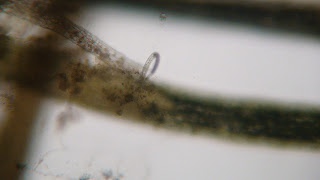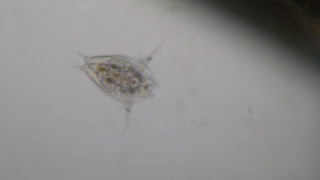I observed my MicroAquarium on October 20, 2011 (approximately 9 days after putting it together). To recap, my water and substrate was from Source 8 (the Tennessee River near Neyland Stadium), and I added moss from
a natural spring at Carters Mill Park (Amblestegium sp.) and whose original material was from south shore of Spain Lake ( in White County and grown in water tanks outside of greenhouse at Hesler Biology Building (ricularia gibba L.).
During this observation, I noted several organisms in the water and among the mosses. I did not, however, find any organisms in the substrate.
The first organism I saw I identified as Actinosphaerium (Patterson 1996, Figure 395). I saw several of these organisms throughout the MicroAquarium but mostly in the middle and lower levels. Below is a picture of one such organism.
 |
Actinospaerium
(Patterson 1996, Figure 395) |
I also identified Nematoda (Smith 2001, Figure 8.1), which appeared to be stuck in one of the moss samples. This Nematoda, which I could not classify more specifically, can be seen in the picture below.
 |
Nematoda
(Smith 2001, Figure 8.1) |
Additionally, I identified the nymph of a Cyclpoid nauplius (Smith 2001, Figure 19.6). This organism was very fast-moving and hard to capture on camera. An image of the immature copepoda can be seen below.
 |
Cyclopoid nauplius Nypmh
(Smith 2001, Figure 19.6) |
Below is an image of Vorticella (Patterson 1996, Figure 233). This organsim could be found in many areas of the MicroAquarium. The movement of the organism is interesting in that it pulls water through itself in order to eat. Additionally, I witnessed it curling up when it was hit by a larger organism that was careening around the habitat (classification of larger organism unknown).
 |
Vorticella
(Patterson 1996, Figure 233) |
I was also lucky enough to have a protozoa called Campanella in my MicroAquarium (Bick 2972, Figure 61). To me, this organism looked like a two-headed vorticella and appeared to function similarly (pulling water through itself to catch organisms).
 |
Campanella
(Bick 2972, Figure 61) |
I saw several other organisms in my MicroAquarium, including a Tachysoma (Patterson 1996, Figure 265), several kinds of algae, and several unidentified organisms. I plan to observe my MicroAquarium again on Thursday.
Sources:
Bick, H. (1972). Ciliated protozoa. Geneva, Switzerland: World Health Organization.
Patterson, D.J. (1996). Free-living freshwater protozoa: a colour guide. Washington, D.C.: ASM Press.
Smith, D. G. (2001). Pennak's freshwater invertebrates of the United States. New York, NY: John Wiley
and Sons, Inc.

